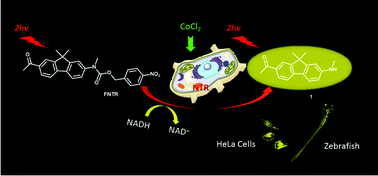A two-photon fluorescent probe for nitroreductase imaging in living cells, tissues and zebrafish under hypoxia conditions†
Abstract
A two-photon fluorescent probe FNTR for nitroreductase was synthesized by using 9,9-dimethyl-2-acetyl-fluoren-7-methylamino (1) as a two-photon fluorophore and a p-nitrobenzyl carbamate group as a recognition domain for nitroreductase (NTR). The probe and the fluorophore were tested under one- and two-photon modes respectively. After reacting with nitroreductase, FNTR had a 130-fold fluorescence enhancement at 563 nm in 10 min and the maximal two-photon action cross-section value was detected as 66 GM at 750 nm. The probe showed a high sensitivity with a detection limit as low as 23.67 ng ml−1, high selectivity, low cytotoxicity and good photostability. In the presence of reduced nicotinamide adenine dinucleotide (NADH), endogenous NTR was detected in living cells, tissues and zebrafish. Cobalt chloride was used to induce chemical hypoxia to produce NTR, which generated enhanced fluorescence in cells and tumor tissues. Finally, two-photon fluorescence imaging of NTR was achieved in zebrafish at a penetration depth of up to 200 μm.



 Please wait while we load your content...
Please wait while we load your content...